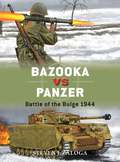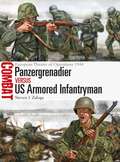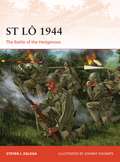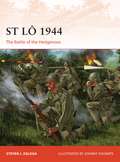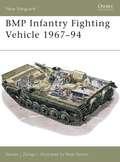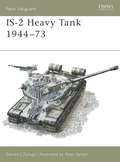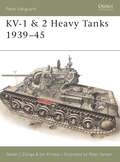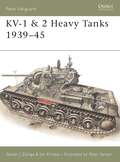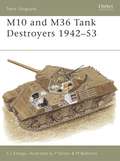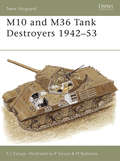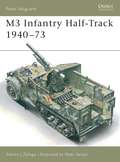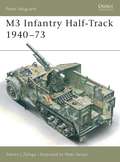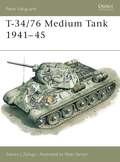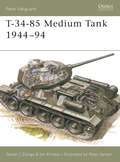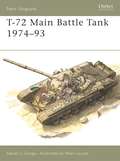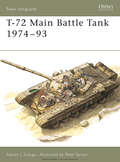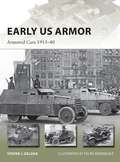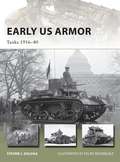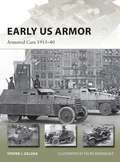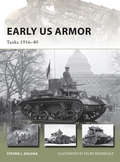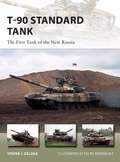- Table View
- List View
Bazooka vs Panzer: Battle of the Bulge 1944 (Duel #77)
by Steven J. Zaloga Johnny Shumate Alan GillilandWorld War II saw tanks assume a dominant role in warfare, capable of tearing through the enemy lines if left unchecked. To combat the threat posed by these armoured behemoths the United States developed the M1 Anti-Tank Rocket Launcher, better known as the Bazooka. First employed in combat during 1942, the weapon required a great deal of skill and courage to use effectively. By late 1944 it was a mainstay of the US infantry's anti-tank capabilities, alongside towed weapons, anti-tank grenades and other longer-established measures.Focusing on the savage close-quarters fighting between Germany's armoured divisions and the US infantry during the Battle of the Bulge, Steven Zaloga's absorbing study compares and assesses the strengths and limitations of the cutting-edge technology used by both sides. Featuring specially commissioned full-colour artwork and explosive battle reports, this volume casts new light on the evolving nature of infantry-versus-tank combat in the closing months of World War II.
Panzergrenadier vs US Armored Infantryman: European Theater of Operations 1944 (Combat #22)
by Steven J. Zaloga Johnny ShumateDuring World War II, the two pre-eminent mechanized infantry forces of the conflict, the German Panzergrenadier arm and the US Army's armoured infantrymen, clashed in France and Belgium after the Normandy landings. These engagements went on to profoundly influence the use of mechanized infantry in the post-war world. Drawing upon a variety of sources, this book focuses on three key encounters between July and December 1944 including during Operation Cobra and the Battle of the Bulge, and examines the origins, equipment, doctrine and combat record of both forces.With specially commissioned full-colour artwork and maps, this study sheds light on the evolving nature of mechanized warfare at the height of World War II.
Panzergrenadier vs US Armored Infantryman: European Theater of Operations 1944 (Combat #22)
by Steven J. Zaloga Johnny ShumateDuring World War II, the two pre-eminent mechanized infantry forces of the conflict, the German Panzergrenadier arm and the US Army's armoured infantrymen, clashed in France and Belgium after the Normandy landings. These engagements went on to profoundly influence the use of mechanized infantry in the post-war world. Drawing upon a variety of sources, this book focuses on three key encounters between July and December 1944 including during Operation Cobra and the Battle of the Bulge, and examines the origins, equipment, doctrine and combat record of both forces.With specially commissioned full-colour artwork and maps, this study sheds light on the evolving nature of mechanized warfare at the height of World War II.
St Lô 1944: The Battle of the Hedgerows (Campaign)
by Steven J. Zaloga Johnny ShumateFollowing the D-Day landings on 6 June 1944, the First US Army engaged in a six-week struggle to break out of the Normandy beach-head. The hedgerow country of lower Normandy, called the Bocage, presented unanticipated tactical problems since it proved to be ideal for German infantry defense. This book examines the brutal attritional struggle in June-July 1944 to overcome the determined German defense and secure St Lô. The city was the site of a crucial cross-roads and was thus a vital target for the invading Allied forces; the initial bombing attacks were so severe that the journalist and poet Samuel Beckett would later report that it had been 'bombed out of existence in one night'. The attack by ground forces turned into a brutal attritional struggle to overcome the determined German defense. Using full-colour artwork, photographs and maps, this is the engaging story of one of the key engagements in the Battle of Normandy.
St Lô 1944: The Battle of the Hedgerows (Campaign)
by Steven J. Zaloga Johnny ShumateFollowing the D-Day landings on 6 June 1944, the First US Army engaged in a six-week struggle to break out of the Normandy beach-head. The hedgerow country of lower Normandy, called the Bocage, presented unanticipated tactical problems since it proved to be ideal for German infantry defense. This book examines the brutal attritional struggle in June-July 1944 to overcome the determined German defense and secure St Lô. The city was the site of a crucial cross-roads and was thus a vital target for the invading Allied forces; the initial bombing attacks were so severe that the journalist and poet Samuel Beckett would later report that it had been 'bombed out of existence in one night'. The attack by ground forces turned into a brutal attritional struggle to overcome the determined German defense. Using full-colour artwork, photographs and maps, this is the engaging story of one of the key engagements in the Battle of Normandy.
BMP Infantry Fighting Vehicle 1967–94 (New Vanguard)
by Steven J. Zaloga Peter SarsonThe Russian BMP infantry fighting vehicle (IFV) was one of the most significant innovations in infantry tactics in the latter half of the 20th century. Built in response to the threat of nuclear warfare, it was the world's first IFV, providing the infantry squad with unprecedented firepower, mobility and protection. With over 55,000 manufactured since 1966, the BMP is also numerically one of the most important armoured vehicles ever built. This richly illustrated book examines the development and design of the BMP, detailing its armaments, performance in combat and variants.
BMP Infantry Fighting Vehicle 1967–94 (New Vanguard #12)
by Steven J. Zaloga Peter SarsonThe Russian BMP infantry fighting vehicle (IFV) was one of the most significant innovations in infantry tactics in the latter half of the 20th century. Built in response to the threat of nuclear warfare, it was the world's first IFV, providing the infantry squad with unprecedented firepower, mobility and protection. With over 55,000 manufactured since 1966, the BMP is also numerically one of the most important armoured vehicles ever built. This richly illustrated book examines the development and design of the BMP, detailing its armaments, performance in combat and variants.
IS-2 Heavy Tank 1944–73 (New Vanguard)
by Steven J. Zaloga Peter SarsonThe Iosef Stalin tanks were the ultimate heavy tanks developed by the Soviet Union and were popularly called 'Victory tanks' due to their close association with the defeat of Germany in 1945. Yet in spite of their reputation, the Stalin tanks emerged from a troubled design, had a brief moment of glory in 1944 and 1945, and disappeared in ignominy after 1960. This title covers the events contributing to the Soviet Union's need to design the new series, with particular reference to the unsuccessful KV series and the advent of a new generation of heavy German tanks including the Tiger. It also covers their development, operational history and myriad variants.
KV-1 & 2 Heavy Tanks 1939–45 (New Vanguard)
by Steven J. Zaloga Peter SarsonNamed after Klimenti Voroshilov, the People's Commissar for Defence, the KVs proved a nasty surprise for German tank crews during the early days of Operation Barbarossa. Although slow, they were extremely heavily armoured. This volume examines the transition from multi-turreted tanks to heavy single-turret vehicles, consisting of the KV-1 and 2, and the increased favour given to the heavy single-turret after the Germans began to develop ammunition capable of penetrating even the thickest armour, whilst detailing the design, development and operational history of the Soviet Union's monstrous KV series of tanks.
KV-1 & 2 Heavy Tanks 1939–45 (New Vanguard #17)
by Steven J. Zaloga Peter SarsonNamed after Klimenti Voroshilov, the People's Commissar for Defence, the KVs proved a nasty surprise for German tank crews during the early days of Operation Barbarossa. Although slow, they were extremely heavily armoured. This volume examines the transition from multi-turreted tanks to heavy single-turret vehicles, consisting of the KV-1 and 2, and the increased favour given to the heavy single-turret after the Germans began to develop ammunition capable of penetrating even the thickest armour, whilst detailing the design, development and operational history of the Soviet Union's monstrous KV series of tanks.
M10 and M36 Tank Destroyers 1942–53 (New Vanguard)
by Steven J. Zaloga Peter SarsonThe US Army had a unique tactical doctrine during World War II, placing the emphasis for tank fighting on its Tank Destroyer Command whose main early-war vehicle was the M10 3-inch Gun Motor Carriage, based on the reliable M4A2 Sherman tank chassis. This durable and versatile vehicle saw combat service from the North Africa campaign in 1943. By 1944, its gun was not powerful enough and it was rearmed with the new 90 mm gun, becoming the M36 90mm Gun Motor Carriage. This book details one of the only US armoured vehicles capable of dealing with the Panther and Tiger during the Battle of the Bulge.
M10 and M36 Tank Destroyers 1942–53 (New Vanguard)
by Steven J. Zaloga Peter SarsonThe US Army had a unique tactical doctrine during World War II, placing the emphasis for tank fighting on its Tank Destroyer Command whose main early-war vehicle was the M10 3-inch Gun Motor Carriage, based on the reliable M4A2 Sherman tank chassis. This durable and versatile vehicle saw combat service from the North Africa campaign in 1943. By 1944, its gun was not powerful enough and it was rearmed with the new 90 mm gun, becoming the M36 90mm Gun Motor Carriage. This book details one of the only US armoured vehicles capable of dealing with the Panther and Tiger during the Battle of the Bulge.
M3 Infantry Half-Track 1940–73 (New Vanguard)
by Steven J. Zaloga Peter SarsonAs armoured warfare tactics matured, mechanised infantry became a key ingredient in what is now called 'combined arms' doctrine. For the US Army of World War 2, the most important technical aspect of infantry mechanisation was the development of the M3 half-track personnel carrier. Steven Zaloga guides the reader through the early 1930s development of the half-track, its first deployment in action in the Philippines in 1941 and its varied and vital role in international deployments since World War 2. This authoritative text also examines the operators of half-tracks and the troops that they carried.
M3 Infantry Half-Track 1940–73 (New Vanguard #11)
by Steven J. Zaloga Peter SarsonAs armoured warfare tactics matured, mechanised infantry became a key ingredient in what is now called 'combined arms' doctrine. For the US Army of World War 2, the most important technical aspect of infantry mechanisation was the development of the M3 half-track personnel carrier. Steven Zaloga guides the reader through the early 1930s development of the half-track, its first deployment in action in the Philippines in 1941 and its varied and vital role in international deployments since World War 2. This authoritative text also examines the operators of half-tracks and the troops that they carried.
T-34/76 Medium Tank 1941–45 (New Vanguard)
by Steven J. Zaloga Peter SarsonThe T-34 was the most influential tank design of World War 2. When first introduced into combat in the summer of 1941, it represented a revolutionary leap forward in tank design. Its firepower, armour protection and mobility were superior to that of any other medium tank of the period. This superiority did not last long. While the T-34 underwent a series of incremental improvements during 1943, it was being surpassed by new German tank designs, most notably the Panther. This title traces the life of the original T-34 through all its difficulties to eventual success.
T-34/76 Medium Tank 1941–45 (New Vanguard #9)
by Steven J. Zaloga Peter SarsonThe T-34 was the most influential tank design of World War 2. When first introduced into combat in the summer of 1941, it represented a revolutionary leap forward in tank design. Its firepower, armour protection and mobility were superior to that of any other medium tank of the period. This superiority did not last long. While the T-34 underwent a series of incremental improvements during 1943, it was being surpassed by new German tank designs, most notably the Panther. This title traces the life of the original T-34 through all its difficulties to eventual success.
T-34-85 Medium Tank 1944–94 (New Vanguard)
by Steven J. Zaloga Peter SarsonThe T-34-85 tank is one of those rare weapons that have remained in service for more than half a century. First introduced in 1944, it has seen combat in nearly every corner of the globe. Steven Zaloga and Jim Kinnear look at this long-serving tank at length. Although long obsolete in Europe, it has proven a reliable and potent weapon in many Third World conflicts, and is still in service with more than a dozen armies around the world.
T-72 Main Battle Tank 1974–93 (New Vanguard)
by Steven J. Zaloga Peter SarsonThe Russian T-72 Ural tank is the most widely-deployed main battle tank of the current generation. Used by the armies of the former Warsaw pact and Soviet Union, it has also been exported in large numbers to many of the states in the Middle East. This book reveals the previously secret history behind the tank. Steven J Zaloga examines the conditions under which the T-72 was designed and produced. Technical aspects of the weapon are also discussed, including its EDZ reactive armour which, when it first appeared in December 1984, gave NATO a nasty shock.
T-72 Main Battle Tank 1974–93 (New Vanguard #6)
by Steven J. Zaloga Peter SarsonThe Russian T-72 Ural tank is the most widely-deployed main battle tank of the current generation. Used by the armies of the former Warsaw pact and Soviet Union, it has also been exported in large numbers to many of the states in the Middle East. This book reveals the previously secret history behind the tank. Steven J Zaloga examines the conditions under which the T-72 was designed and produced. Technical aspects of the weapon are also discussed, including its EDZ reactive armour which, when it first appeared in December 1984, gave NATO a nasty shock.
Early US Armor: Armored Cars 1915–40 (New Vanguard #245)
by Steven J. Zaloga Mr Felipe RodríguezThe first American armoured cars began to emerge around the turn of the century, seeing their first military use in 1916 during the Punitive Expedition against Pancho Villa. When the United States entered World War I, the American Expeditionary Forces used some armoured cars in France, and American armoured cars were used by the French Army. The inter-war years saw considerable innovation and experimentation in armoured car design. Of the 1930s scout car designs, the M3A1 scout car was good enough to be produced in very large numbers in World War II, and was widely exported to many other armies via Lend-Lease. It also served as the basis for the late M2 and M3 armoured half-tracks. In this study, using detailed full colour plates and rigorous analysis, US armour expert Steven J. Zaloga chronicles the development of the US armoured car in the years leading up to World War II.
Early US Armor: Tanks 1916–40 (New Vanguard)
by Steven J. Zaloga Felipe RodríguezBetween the two World Wars, the US contributed significantly to the development of the tank, a weapon invented by the British and the French seeking a way to break through the lines of German trenches. From the employment of the French Renault FT and British Mark V during their involvement in World War I, the US branched out with their own indigenous designs including the M1 Cavalry Car and the M2 Light and Medium tanks, the precursors to the Stuart and Grant tanks of World War II. Tank designers in this period faced unique challenges and so the story of early American armour is littered with failures amongst the successes. Featuring previously unpublished photos and fully illustrated throughout, Early American Armor (1): Tanks 1916–40 is essential reading for anyone interested in American armour, or in the development of tank design.
Early US Armor: Armored Cars 1915–40 (New Vanguard #254)
by Steven J. Zaloga Felipe RodríguezThe first American armoured cars began to emerge around the turn of the century, seeing their first military use in 1916 during the Punitive Expedition against Pancho Villa. When the United States entered World War I, the American Expeditionary Forces used some armoured cars in France, and American armoured cars were used by the French Army. The inter-war years saw considerable innovation and experimentation in armoured car design. Of the 1930s scout car designs, the M3A1 scout car was good enough to be produced in very large numbers in World War II, and was widely exported to many other armies via Lend-Lease. It also served as the basis for the late M2 and M3 armoured half-tracks. In this study, using detailed full colour plates and rigorous analysis, US armour expert Steven J. Zaloga chronicles the development of the US armoured car in the years leading up to World War II.
Early US Armor: Tanks 1916–40 (New Vanguard)
by Steven J. Zaloga Felipe RodríguezBetween the two World Wars, the US contributed significantly to the development of the tank, a weapon invented by the British and the French seeking a way to break through the lines of German trenches. From the employment of the French Renault FT and British Mark V during their involvement in World War I, the US branched out with their own indigenous designs including the M1 Cavalry Car and the M2 Light and Medium tanks, the precursors to the Stuart and Grant tanks of World War II. Tank designers in this period faced unique challenges and so the story of early American armour is littered with failures amongst the successes. Featuring previously unpublished photos and fully illustrated throughout, Early American Armor (1): Tanks 1916–40 is essential reading for anyone interested in American armour, or in the development of tank design.
T-90 Standard Tank: The First Tank of the New Russia (New Vanguard)
by Steven J. Zaloga Felipe RodríguezIn the wake of the T-72 tank's poor performance in the 1991 Gulf War, the Kremlin instructed the Russian tank industry to drop the discredited T-72 designation in favour of the T-90 Vladimir. The T-90 was in fact a further evolution of the T-72 family, but the name change represented an important break in Russian/Soviet tank design history. The T-90 has become the principal export tank of Russia, and is in service in large numbers in many countries including Algeria, India, and many of the former Soviet republics. Using detailed illustrations and full colour artwork, this book will also describe the evolution of the T-90s many failed successors including the little known Bokser, Molot, and T-95, as well as its likely successor, the new T-14 Armata, and the wide range of specialized vehicles based on the T-90 chassis such as the formidable Terminator tank support vehicle.
T-90 Standard Tank: The First Tank of the New Russia (New Vanguard #255)
by Steven J. Zaloga Felipe RodríguezIn the wake of the T-72 tank's poor performance in the 1991 Gulf War, the Kremlin instructed the Russian tank industry to drop the discredited T-72 designation in favour of the T-90 Vladimir. The T-90 was in fact a further evolution of the T-72 family, but the name change represented an important break in Russian/Soviet tank design history. The T-90 has become the principal export tank of Russia, and is in service in large numbers in many countries including Algeria, India, and many of the former Soviet republics. Using detailed illustrations and full colour artwork, this book will also describe the evolution of the T-90s many failed successors including the little known Bokser, Molot, and T-95, as well as its likely successor, the new T-14 Armata, and the wide range of specialized vehicles based on the T-90 chassis such as the formidable Terminator tank support vehicle.
